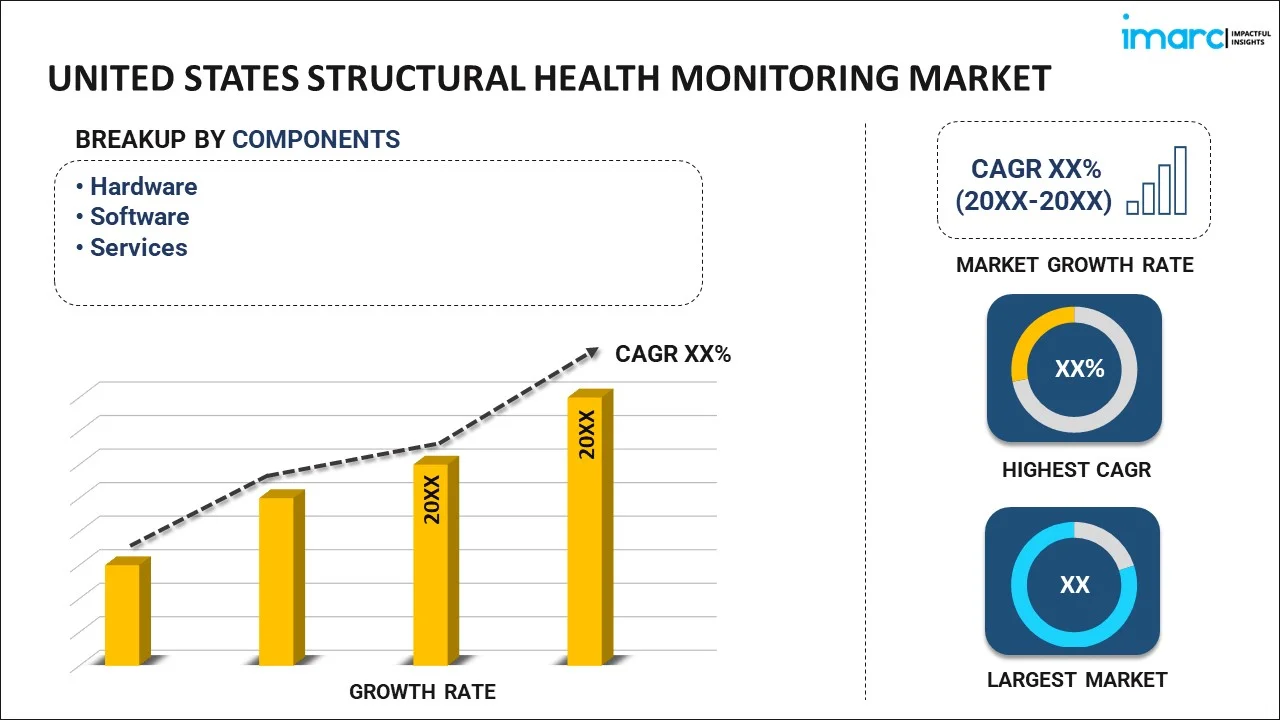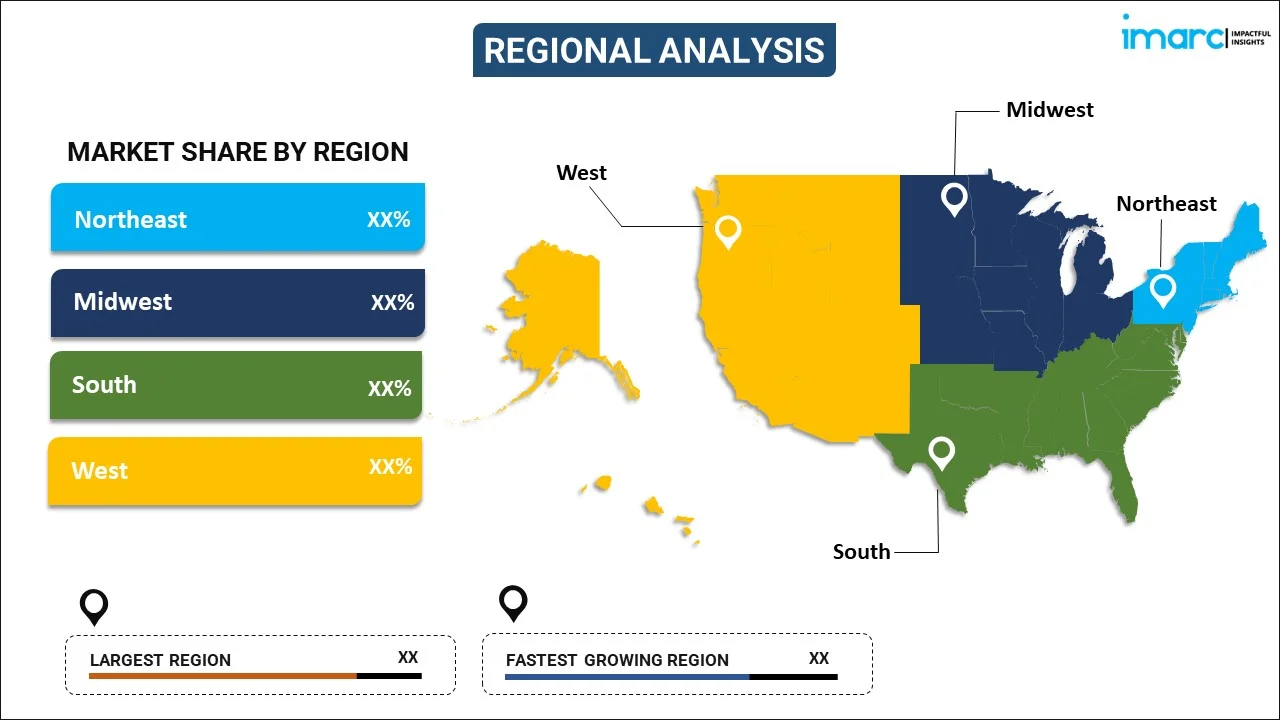
United States Structural Health Monitoring Market Report by Component (Hardware, Software, Services), Technology (Wired, Wireless), Implementation Method (New Construction, Retrofitting), Vertical (Civil Infrastructure, Aerospace and Defense, Energy, Mining, and Others), and Region 2024-2032
Market Overview:
United States structural health monitoring market size is projected to exhibit a growth rate (CAGR) of 13.40% during 2024-2032. The rising construction of residential and commercial buildings, increasing frequency of natural disasters, such as hurricanes and earthquakes, and the growing emphasis on sustainability and reducing the environmental footprint of infrastructure projects represent some of the key factors driving the market.
|
Report Attribute
|
Key Statistics
|
|---|---|
|
Base Year
|
2023 |
|
Forecast Years
|
2024-2032
|
|
Historical Years
|
2018-2023
|
| Market Growth Rate (2024-2032) | 13.40% |
Structural health monitoring (SHM) is a systematic process of monitoring and assessing the condition and performance of various structures, such as buildings, bridges, dams, and aerospace components, to ensure their safety, longevity, and efficiency. It relies on the integration of sensors, data analysis techniques, and advanced technologies to detect, evaluate, and predict potential issues or defects in these structures. It provides real-time or periodic monitoring, enabling early detection of structural damage or degradation. It helps identify potential structural issues before they become critical, minimizing the risk of accidents or failures. It reduces the need for expensive repairs or replacements, ultimately saving on maintenance costs. It enables proactive maintenance, ensuring that structures operate at their best performance levels. It is extensively used in assessing the health of bridges, buildings, and tunnels, ensuring the safety of infrastructure. It is also utilized in wind turbines and power plants to monitor critical components and prevent downtime. Moreover, it is employed in offshore platforms and pipelines to detect corrosion and structural weaknesses.
United States Structural Health Monitoring Market Trends:
The rising construction of residential and commercial buildings in the United States represents one of the primary factors driving the demand for SHM. Additionally, the increasing number of aging infrastructures is offering a favorable market outlook. SHM provides real-time data on the condition of these aging structures, aiding in timely maintenance and repairs. Along with this, the increasing frequency of natural disasters, such as hurricanes and earthquakes, is driving the need for continuous structural monitoring to detect vulnerabilities and potential failures. Apart from this, regulatory bodies in the United States are imposing stricter guidelines for the maintenance of critical infrastructure, which is catalyzing the demand for SHM. Furthermore, the development of advanced sensors, data analytics tools, and communication technologies is enhancing the capabilities of SHM systems. These technological advancements make SHM more accessible and effective, driving its adoption. Moreover, the growing emphasis on sustainability and reducing the environmental footprint of infrastructure projects is influencing the market positively. SHM can contribute to sustainability efforts by extending the lifespan of structures and reducing the need for resource-intensive reconstruction. In line with this, the increasing reliance of organizations in the United States on data-driven insights to make informed decisions is creating a positive outlook for the market. Besides this, the integration of the Internet of Things (IoT) into SHM systems is allowing for the collection of vast amounts of data from sensors distributed throughout structures. This data can be analyzed in real-time, enabling predictive maintenance and reducing downtime.
United States Structural Health Monitoring Market Segmentation:
IMARC Group provides an analysis of the key trends in each segment of the market, along with forecasts at the country level for 2024-2032. Our report has categorized the market based on component, technology, implementation method, and vertical.
Component Insights:

- Hardware
- Software
- Services
The report has provided a detailed breakup and analysis of the market based on the component. This includes hardware, software, and services.
Technology Insights:
- Wired
- Wireless
A detailed breakup and analysis of the market based on technology have also been provided in the report. This includes wired and wireless.
Implementation Method Insights:
- New Construction
- Retrofitting
The report has provided a detailed breakup and analysis of the market based on the implementation method. This includes new construction and retrofitting.
Vertical Insights:
- Civil Infrastructure
- Aerospace and Defense
- Energy
- Mining
- Others
A detailed breakup and analysis of the market based on vertical have also been provided in the report. This includes civil infrastructure, aerospace and defense, energy, mining, and others.
Regional Insights:

- Northeast
- Midwest
- South
- West
The report has also provided a comprehensive analysis of all the major regional markets, which include the Northeast, Midwest, South, and West.
Competitive Landscape:
The market research report has also provided a comprehensive analysis of the competitive landscape in the market. Competitive analysis such as market structure, key player positioning, top winning strategies, competitive dashboard, and company evaluation quadrant has been covered in the report. Also, detailed profiles of all major companies have been provided.
United States Structural Health Monitoring Market Report Coverage:
| Report Features | Details |
|---|---|
| Base Year of the Analysis | 2023 |
| Historical Period | 2018-2023 |
| Forecast Period | 2024-2032 |
| Units | US$ Million |
| Scope of the Report | Exploration of Historical and Forecast Trends, Industry Catalysts and Challenges, Segment-Wise Historical and Predictive Market Assessment:
|
| Components Covered | Hardware, Software, Services |
| Technologies Covered | Wired, Wireless |
| Implementation Methods Covered | New Construction, Retrofitting |
| Verticals Covered | Civil Infrastructure, Aerospace and Defense, Energy, Mining, Others |
| Regions Covered | Northeast, Midwest, South, West |
| Customization Scope | 10% Free Customization |
| Report Price and Purchase Option | Single User License: US$ 3699 Five User License: US$ 4699 Corporate License: US$ 5699 |
|
Post-Sale Analyst Support |
10-12 Weeks |
| Delivery Format | PDF and Excel through Email (We can also provide the editable version of the report in PPT/Word format on special request) |
Key Questions Answered in This Report:
- How has the United States structural health monitoring market performed so far and how will it perform in the coming years?
- What has been the impact of COVID-19 on the United States structural health monitoring market?
- What is the breakup of the United States structural health monitoring market on the basis of component?
- What is the breakup of the United States structural health monitoring market on the basis of technology?
- What is the breakup of the United States structural health monitoring market on the basis of implementation method?
- What is the breakup of the United States structural health monitoring market on the basis of vertical?
- What are the various stages in the value chain of the United States structural health monitoring market?
- What are the key driving factors and challenges in the United States structural health monitoring?
- What is the structure of the United States structural health monitoring market and who are the key players?
- What is the degree of competition in the United States structural health monitoring market?
Key Benefits for Stakeholders:
- IMARC’s industry report offers a comprehensive quantitative analysis of various market segments, historical and current market trends, market forecasts, and dynamics of the United States structural health monitoring market from 2018-2032.
- The research report provides the latest information on the market drivers, challenges, and opportunities in the United States structural health monitoring market.
- Porter's five forces analysis assist stakeholders in assessing the impact of new entrants, competitive rivalry, supplier power, buyer power, and the threat of substitution. It helps stakeholders to analyze the level of competition within the United States structural health monitoring industry and its attractiveness.
- Competitive landscape allows stakeholders to understand their competitive environment and provides an insight into the current positions of key players in the market.
Need more help?
- Speak to our experienced analysts for insights on the current market scenarios.
- Include additional segments and countries to customize the report as per your requirement.
- Gain an unparalleled competitive advantage in your domain by understanding how to utilize the report and positively impacting your operations and revenue.
- For further assistance, please connect with our analysts.
 Inquire Before Buying
Inquire Before Buying
 Speak to an Analyst
Speak to an Analyst
 Request Brochure
Request Brochure
 Request Customization
Request Customization




.webp)




.webp)












